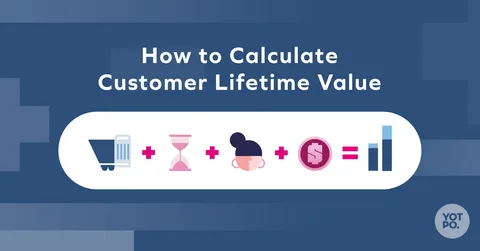
Every business—whether a new startup or an established enterprise—strives for sustainable growth. While many focus on increasing sales or trimming expenses, one metric offers a more strategic pathway: customer lifetime value (CLV). More than just a formula, the customer lifetime value calculation reveals the long-term value of your customers, guiding decisions that can enhance profitability and business resilience. This guide breaks down how to calculate CLV step by step and how to use it to fuel lasting success.
Why CLV Deserves a Central Role
Customer lifetime value measures the total revenue a business can expect from a single customer over the entire span of their relationship. It goes beyond individual transactions to account for repeat purchases, loyalty, and even referrals.
Unlike short-term metrics like monthly revenue, CLV shifts your focus to long-term profitability. It highlights which customers are most valuable and helps identify where to allocate time, money, and effort. Whether you’re running an online store or a local service, understanding CLV can be the key to building a more resilient, future-ready business.
Step 1: Collect Essential Data
Before you can calculate CLV, gather the right data points. You’ll need:
- Average Purchase Value: Total revenue over a period divided by the number of purchases.
- Purchase Frequency: Total purchases divided by the number of unique customers.
- Customer Lifespan: The average length of time a customer remains active, measured in months or years.
For example, a subscription service might look at the average subscription duration, while a retailer might calculate the time between a customer’s first and last purchase. Even if your data isn’t perfect, starting with rough estimates can lay the groundwork for improvement.
Step 2: Use the Basic CLV Formula
With your core data in hand, apply the basic CLV formula:
CLV = Average Purchase Value × Purchase Frequency × Customer Lifespan
Consider a gym where members spend $50 per month, attend once a month (12 times a year), and stay for 3 years. The basic CLV would be:
$50 × 12 × 3 = $1,800
This simple calculation gives a solid starting point, even for businesses without advanced analytics systems. However, it only provides a revenue estimate. To get a more accurate picture of profitability, you’ll need to factor in costs.
Refining CLV with Costs and Margins
A more realistic CLV includes the cost of acquiring and serving customers. This version accounts for profitability by adding:
- Customer Acquisition Cost (CAC): Total marketing/sales spend divided by the number of new customers.
- Gross Margin: The percentage of revenue remaining after subtracting the cost of goods sold.
Refined CLV = (Average Purchase Value × Purchase Frequency × Customer Lifespan) × Gross Margin – CAC
Revisiting the gym example: If the gross margin is 70% and CAC is $200:
($1,800 × 0.70) – $200 = $1,060
This adjusted CLV shows how much net value each customer contributes, helping you make smarter investments in marketing and customer service.
Step 3: Factor in Retention and Churn
Customer lifespan is influenced by how long customers stick around. Retention rates and churn—the percentage of customers lost over time—are crucial to understanding CLV accurately.
If your annual retention rate is 80%, you can estimate average lifespan as:
1 ÷ (1 – Retention Rate) = 1 ÷ 0.20 = 5 years
A coffee shop with a $5 average purchase and 50 visits per year would have a CLV of:
$5 × 50 × 2 = $500 (with a 50% annual churn rate)
Improve retention to 75%, and the lifespan doubles to 4 years—raising CLV to $1,000. Increasing retention isn’t just good service—it’s a revenue multiplier.
Applying CLV to Business Strategy
Once you’ve calculated CLV, use it to drive smarter strategies. A high CLV allows you to spend more on acquiring valuable customers, while also justifying investments in loyalty programs and customer service.
For example, if an online retailer finds that customers who buy premium products have a CLV three times higher than average, they can prioritize upselling and personalized offers for that segment. Businesses can also shift marketing budgets toward re-engagement campaigns instead of broad awareness ads, focusing resources where they have the greatest impact.
Watch Out for Common Pitfalls
Calculating CLV isn’t always straightforward. Be mindful of these common issues:
- Data gaps: Incomplete or inaccurate data can distort results.
- Overestimated lifespans: Be conservative with retention assumptions.
- One-time calculations: CLV should evolve as your customer behavior changes.
Even small businesses can begin with a simple spreadsheet and refine their approach over time. What matters most is consistent measurement and continuous improvement.
Scaling CLV with Advanced Tools
For businesses with more data and resources, advanced CLV methods offer even greater insights. Techniques like predictive analytics can forecast customer behavior and segment users by value. This enables:
- Hyper-targeted marketing
- Churn prevention strategies
- Custom loyalty offers
You can also apply discount rates to account for the time value of money, particularly in industries with long customer relationships. While these approaches require more sophistication, they transform CLV from a historical metric into a predictive growth engine.
Building a Business That Lasts
Learning how to calculate customer lifetime value is more than a mathematical exercise—it’s a strategic mindset. CLV encourages you to view customers as long-term partners, not just one-time transactions. By embedding CLV into your business operations, you create a framework for sustainable growth—one that balances acquisition, retention, and profitability.
In an increasingly competitive landscape, this long-view approach helps you make smarter decisions, invest where it counts, and ultimately build a business designed to endure.






